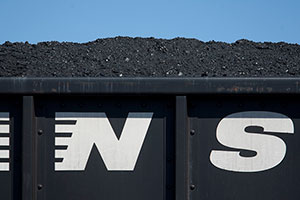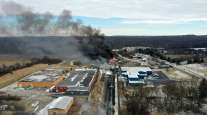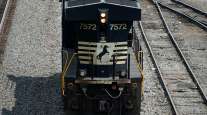Railroads Close Tracks, Cut Jobs Across the Country as Coal Cools Off

Working in or around Conway Terminal, the sprawling testament to the might of the U.S. freight railroad system, it might be easy to forget the storm of troubles brewing at Norfolk Southern Corp.
The Virginia-based rail carrier has long experienced the booms and busts of products and commodities in the broader U.S. economy, and so have its workers at Conway Terminal, one of the largest rail yards in the country that hugs the Ohio River in Beaver County.
But the recent and historic decline of coal — long the most important commodity hauled through Pennsylvania — has represented a significant hit for the financially ailing Norfolk Southern, which owns Conway and all the traffic that moves through it.
Furloughs that began last month served as a wake-up call for Heath Vezza, vice president of the workers union representing about 325 track maintenance employees in the central operating division in Pennsylvania. Vezza said 12 of his union workers — younger employees hired from 2012 to 2015 — have been furloughed at the moment. There have been handfuls of layoffs at other divisions through January, he added, and it’s hard to know how many jobs in total were cut.
“That’s your new generation of railroaders that need to learn from the older employees and to be trained,” Vezza lamented.
Layoffs, facility closures, and the downgrading and selling of rail lines are all on the table as part of Norfolk Southern’s four-year plan presented Jan. 27 to shareholders following a fourth-quarter earnings report. The carrier reported a profit of $1.6 billion in 2015, down 22% from $2 billion in 2014. The decline was spearheaded by a 23% drop in coal revenue, the commodity that makes up nearly a fifth of Norfolk Southern’s total revenue.
The pullback isn’t only being seen at Norfolk Southern.
CSX Corp., which owns a competing rail line across the river from Conway Yard and follows a similar path through Pittsburgh, also plans to continue its years-long effort to reshape its business after coal revenue dived 19% in 2015. The Jacksonville, Fla.-based carrier reported annual earnings of $2 billion in 2015, up 2% from 2014.
Traditionally, coal is the single-most important commodity that freight railroads move, said Noël Perry, a freight transportation expert based in Cornwall, Pennsylvania, with consulting firm FTR Associates. With steady contracts to supply electric utilities or export terminals that guarantee high volumes with little competition, he said, coal has been highly profitable for rail companies.
Coal movement also tends to be more localized than other commodities, meaning entire lines and networks were built and devoted to moving coal from mines to power plants and ports.
“There’s usually nothing else around that the railroads can move easily,” Perry said. “When and if coal goes away, there’s nothing to replace it. So major facilities and major lines get completely abandoned.”
Many of these are smaller, less-trafficked lines owned by short-line companies, such as a 39-mile stretch of the Buffalo & Pittsburgh Railroad that brings coal to the Homer City Generating Station in Indiana County from surrounding mines. Connecticut-based Genesee & Wyoming Inc. spent $21 million in the mid-2000s to revive the line, which had been abandoned years before.
Norfolk Southern plans to downgrade or dispose of 1,500 miles of track by 2020 — shedding 1,000 miles of that this year alone — and collaborate with short-line railroads to manage other segments of track. It plans to lay off 2,000 more employees in “areas affected by lower coal traffic,” cut overtime levels in half from 2015 levels and reduce operations in secondary yards.




